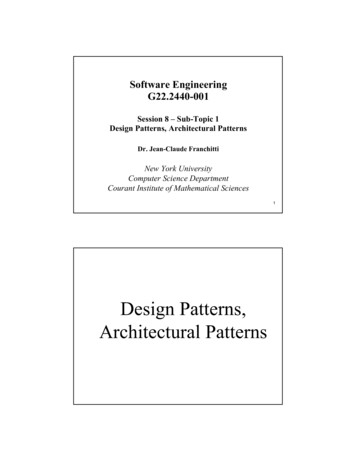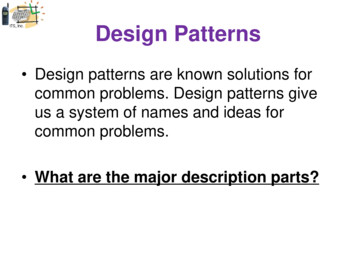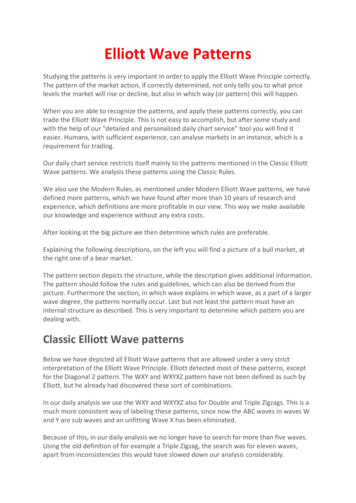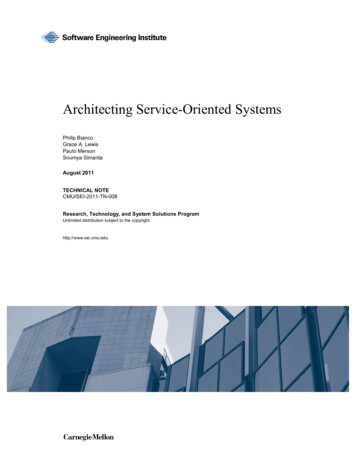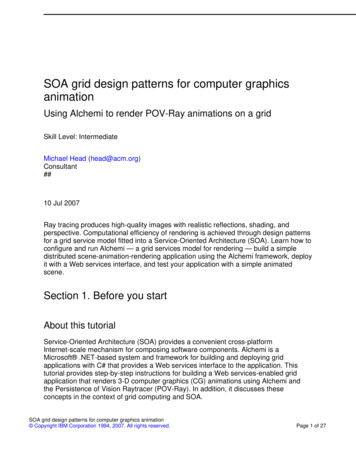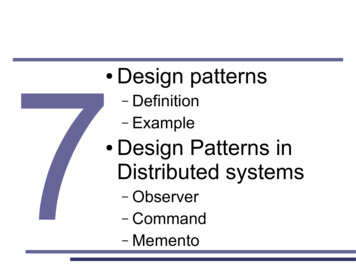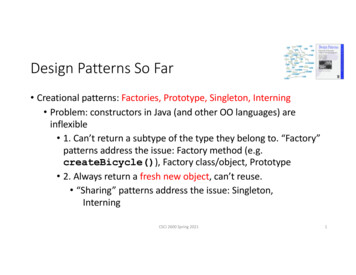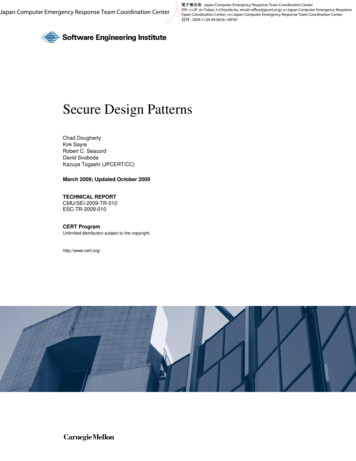
Transcription
Holub on Patterns:Learning Design Patternsby Looking at CodeALLEN HOLUB
Holub on Patterns: Learning Design Patterns by Looking at CodeCopyright 2004 by Allen HolubLead Editor: Gary CornellTechnical Reviewer: Ken ArnoldEditorial Board: Steve Anglin, Dan Appleman, Ewan Buckingham, Gary Cornell, Tony Davis,Jason Gilmore, Jonathan Hassell, Chris Mills, Dominic Shakeshaft, Jim SumserProject Manager: Tracy Brown CollinsCopy Edit Manager: Nicole LeClercCopy Editor: Kim WimpsettProduction Manager: Kari BrooksProduction Editor: Janet VailProofreader: Nancy SixsmithCompositor and Artist: Diana Van Winkle, Van Winkle Design GroupIndexer: Ann RogersArtist: Diana Van Winkle, Van Winkle Design GroupInterior Designer: Diana Van Winkle, Van Winkle Design GroupCover Designer: Kurt KramesManufacturing Manager: Tom DebolskiLibrary of Congress Cataloging-in-Publication Data:Holub, Allen I.Holub on patterns : learning design patterns by looking at code /Allen Holub.p. cm.Includes index.ISBN 1-59059-388-X (alk. paper)1. Software patterns. 2. Object-oriented programming (Computer science) I. Title.QA76.76.P37H65 2004005.1—dc222004019635All rights reserved. No part of this work may be reproduced or transmitted in any form or by any means,electronic or mechanical, including photocopying, recording, or by any information storage or retrievalsystem, without the prior written permission of the copyright owner and the publisher.Printed and bound in the United States of America 9 8 7 6 5 4 3 2Trademarked names may appear in this book. Rather than use a trademark symbol with every occurrenceof a trademarked name, we use the names only in an editorial fashion and to the benefit of the trademarkowner, with no intention of infringement of the trademark.Distributed to the book trade in the United States by Springer-Verlag New York, Inc. 233 Spring Street,6th Floor, New York, New York 10013 and outside the United States by Springer-Verlag GmbH & Co. KG,Tiergartenstr. 17, 69112 Heidelberg, Germany.In the United States: phone 1-800-SPRINGER (1-800-777-4643), fax 201-348-4505,e-mail orders@springer-ny.com, or visit http://www.springer-ny.com. Outside the United States:fax 49 6221 345229, e-mail orders@springer.de, or visit http://www.springer.de.For information on translations, please contact Apress directly at 2560 Ninth Street, Suite 219, Berkeley,CA 94710. Phone 510-549-5930, fax 510-549-5939, e-mail info@apress.com, or visit http://www.apress.com.The information in this book is distributed on an “as is” basis, without warranty. Although every precautionhas been taken in the preparation of this work, neither the author(s) nor Apress shall have any liability toany person or entity with respect to any loss or damage caused or alleged to be caused directly or indirectlyby the information contained in this work.The source code for this book is available to readers at http://www.holub.com/goodies/patterns.
APPENDIX A Design-PatternQuick ReferenceThis appendix is a reference of the Gang-of-Four design patterns, intended to jog yourmemory about how the patterns work. Ironically, the original Gang-of-Four presentation wasthis brief, but they expanded things in the book to make it more accessible. Once you knowthe patterns, however, brevity is good. This catalog probably won’t be of much use if you don’talready have some familiarity with the patterns, however. A lot of the material you’d find in anintroductory-level discussion is either missing or condensed in this appendix.Though I’ve followed the Gang-of-Four organization (alphabetical by category), I havedeliberately not followed the Gang-of-Four format for the pattern description itself. In particular, I’ve restated their “intent” section to make it more understandable. I’ve also used strippeddown examples, and my examples are not the same as the Gang-of-Four examples. In particular,since most of us aren’t doing GUI work, I’ve tried to eliminate GUI-related example code.I’ve tried to make up for some of this brevity by listing places where the design patterns arefound in the Java packages so you can see how they’re applied in practice. (Some patterns don’tappear in Java, in which case the “Usage” example will say so). Also, you can find detailed codesimilar to my stripped-down examples in one of the volumes of Chan, Lee, and Kramer’s TheJava Class Libraries (Addison-Wesley, various editions) or in the Java documentation or tutorialsavailable on the Sun web site.I’ve played fast and loose with the code in the interest of saving space—I’ve omitted requiredimport statements, access privileges, exceptions, and so on. The formatting isn’t ideal in places.I’m assuming you know what you’re doing in the Java-programming department and are moreinterested in the clarity of the example than in having cut-and-paste code. The code won’t alwayscompile cleanly as it stands.Finally, I’ve said a few things in these notes that you may find shocking if you haven’t readthe rest of the book or some of my other work—things such as “objects must be responsiblefor building their own user interfaces.” I simply have no room to explain this sort of thing ina quick reference; you have to read the rest of the book.347
348APPENDIX A DESIGN-PATTERN QUICK REFERENCE[This page intentionally left blank1]1.Rather an odd thing to say, since the page isn’t blank at all—it contains the text “This page intentionally left blank” —but imagine that it’s blank.
APPENDIX A DESIGN-PATTERN QUICK REFERENCECreational PatternsThe creational patterns are all concerned with object creation (fancy that!). Most of them provideways to create objects without knowing exactly what you’re creating (beyond the interfaces supportedby the created objects). Programming in terms of interfaces rather than concrete-classes is essential ifyou intend to write flexible, reusable code. My rule of thumb is that as much as 80 percent of my codeshould be written in terms of interfaces.349
350APPENDIX A DESIGN-PATTERN QUICK REFERENCEAbstract FactoryCreate objects knowing only the interfaces they implement (without knowing the actual class).Typically, create one of a “family” of objects (one of several kinds of Iterators, one of several kinds ofgraphical widgets, and so on).Abstract Factory: Interface tothe actual factory.UserClientAbstractProductCollection «interface» iterator () torycreates hasNext () :boolean next(): Object remove (): voidcreates hasNext () :boolean next(): Object remove (): voidTreeIterator «anonymous»What Problem Does It Solve?Abstract Factory makes it easy to createand manipulate objects without knowingexactly what they are. (This example uses anIterator—it doesn’t care what kind.) This way,it’s easy to add new sorts of concrete productsto the system without changing any of the codethat uses those products.Abstract Factory also makes it easy foryour code to operate in diverse environments.The system creates a unique Concrete Factory(which creates unique Concrete Products)for each environment, but since you use theinterface, you don’t actually know which environment (or which Concrete Product) you’reusing.Pros ( ) and Cons ( ) The anonymity of the Concrete Factory andProduct promotes reuse—the code that usesthese objects doesn’t need to be modified ifthe Factory produces instantiations ofdifferent classes than it used to do.Concrete Factory: Implementsthe Abstract Factory interfaceto create a specific class ofobject.Abstract Product: The sortof product that the AbstractFactory creates.LinkedListIteratorTree iterator () :Iterator hasNext () :boolean next (): Object remove (): voidConcreteProductLinkedList iterator () :IteratorIterator «interface»Concrete Product: The actualobject (whose class you don’tknow) created by the factory.Client: Uses the created objectsonly through their interfaces. If the product doesn’t do what you want, youmay have to change the Abstract Productinterface, which is difficult. (You have tochange all the Concrete Product definitions.)Often Confused WithBuilder: Builder’s Director may use an AbstractFactory to create Builder objects, but the pointof Builder is that the Director doesn’t knowwhat it’s building.Factory Method: A Factory Method—an unfortunate choice of pattern name on the part ofthe Gang of Four—is an abstract method that asubclass overrides. The Abstract-Factory methodthat creates objects is only rarely a FactoryMethod.See AlsoSingleton, Factory Method, Builder
APPENDIX A DESIGN-PATTERN QUICK REFERENCEImplementation Notes and Exampleinterface Collection{ Iterator iterator();//.}interface Iterator{boolean hasNext();Object next();//.}class Tree implements Collection{public Iterator iterator(){return new Iterator(){ // Implement Iterator interface// here (to traverse a Tree).// (See description of Iterator// pattern for implemenation.)}}}class User// uses only interfaces{public void operation( Collection c ){Iterator i c.iterator();while( i.hasNext() )doSomethingWith( i.next() );}}Collection is the Abstract Factory, Iteratoris the Abstract Product, Tree is the ConcreteFactory, and the anonymous-inner-classIterator implementation is the ConcreteProduct.Abstract Factory has many variants, probably the most common of which is a ConcreteFactory that comprises its own interface—no“Abstract Factory” interface as such exists. ThisConcrete Factory is typically a Singleton. Themethods of the class effectively comprisethe Abstract Factory interface.class SingletonFactory{ private static instance newSingletonFactory();public static SingletonFactory instance(){ return instance;}void factoryOperation1(){/*.*/}void factoryOperation2(){/*.*/};}A similar, though more abstract, exampleis described in the entry for Factory Method.No reason exists why, in the no-AbstractFactory variant, the Concrete Factory cannotcreate a user interface that allows the physicaluser to select which of several possible concreteproducts to create. Consider a drawing programwhose “shape” factory creates a user interfaceshowing a palate of possible shapes. The usercan then click a shape to determine whichConcrete Product (shape derivative) to createin response to a newShape() request.Usagef(Collection c){Iterator i c.iterator();//.}Collection and Iterator are the Abstract Factoryand Product. Concrete Factories and Productsare anonymous.ButtonPeer peer t is both a Singleton and an AbstractFactory. Most of the methods of Toolkit areabstract, and getDefaultToolkit() returns anunknown derivative of Toolkit. No need existsfor an Abstract Factory interface per se.URL home new URL("http://www.holub.com");URLConnection c home.getConnection();InputStream in c.getInput();URL is a concrete URLConnection factory, andURLConnection is an abstract InputStream factory,so URLConnection is both an Abstract Product andan Abstract Factory, depending on context. URL,URLConnection, and InputStream are interfaces byuse, not by declaration.351
352APPENDIX A DESIGN-PATTERN QUICK REFERENCEBuilderSeparate the construction of a complex object from its representation so that the same constructionprocess can create different representations without having to modify the constructing r«interface»BuilderCustomer«use» addName (text: String) addAddress (addr: String)Name, Address exportUI (b: Exporter)Concrete ngDirector: Builds an object withoutknowing exactly what it’s building.Builder: Interface used by theDirector to do the construction.Concrete Builder: Actually buildsthe product by following directionsgiven by the Director. Typicallycreated externally (by the Client)or by an Abstract Factory.Product: The object built by theBuilder under the direction ofthe Director. addName (text: String) addAddress (addr: String) getProduct( ): StringJComponentExporter addName (text: String) addAddress (addr: String) getProduct (): JComponent«create»JComponentWhat Problem Does It Solve?Pros ( ) and Cons ( )It’s desirable to separate business logic from UIlogic, but in an OO system you cannot exposeimplementation details. A well-done class definition will not have “get” methods that returnstate information, so an object must build itsown UI. Nonetheless, it’s sometimes necessaryfor an object to build more than one representation of itself, and it’s undesirable to clutterup the business-logic code with the detailsneeded to build multiple representations.Builder solves this problem by puttingthe representation-specific code into a Builderobject that’s distinct from a Director (“business”) object. Builder also easily lets you addrepresentations later without impactingexisting code at all.Non-UI applications: credit-card processing; for example, every credit-card-paymentprocessor requires a different protocol, withidentical information presented in differentways. Builder separates you from the needsof the credit-card processor, letting you builda packet of information without needing toknow which processor will receive that information. The organization of the data is hiddenfrom you in the “concrete builder” that you talkto via a public, processor-independent, interface. Builder nicely isolates the representationof an object from the associated “business”logic, making it easy to add new (or change)representations of an object without modifying business logic. A change in the Builder interface mandateschanges in all implementing classes. It’s awkward to represent some UI elementscleanly in all representations (for example,HTML vs. Swing).Often Confused WithBridge: An application building a UI usingAWT is a Director—the actual representationis unknown to the application. In this way,AWT reifies both Builder and Bridge.Visitor: A visitor could build a UI by visitingevery element of a data structure. It is “pulling”information for UI construction from themodel rather than having that information“pushed” onto it.See AlsoBridge, Visitor
APPENDIX A DESIGN-PATTERN QUICK REFERENCEImplementation Notes and Exampleclass Customer{ private Address address;Private String name;public void exportUI( Exporter b ){ /.}public interface Exporter{ void addName(String text);void addAddress(String addr);//.}}class HTMLExporter implements Customer.Exporter{ // Implement Builder methods here. This// Implementation creates an HTML// representation of the object.//.public String getProduct(){ // Return HTML String.}}class JComponentExporter implements Customer.Exporter{ JComponent product;// Implement Builder methods here. This// Implementation creates a Jcomponent// that represents the object.//.public JComponent getProduct(){ return product;}}class Client{ Employee director;//.public void addYourUITo(JPanel someWindow){ Customer.Exporter b JComponentExporter();director.exportUI( b );someWindow.add( b.getProduct() );}}The createUI() method is passed a Builderthat could be an HTMLExporter (that creates anHTML representation) or a JComponentExporter(that produces a JComponent). The Directorobject doesn’t know which of these productsit is building—it just calls interface methods.The Client object that’s driving this processdoes know what it’s building since it created theBuilder. Consequently, it’s reasonable for it toextract the correct product.You could get better abstraction by usingan Abstract Factory to create the Builder objectsrather than new. By the same token, if all outputwas going to a file, you could add a printYoursefToFile(String name) method to theBuilder interface; the Director could call thatmethod at an appropriate time, and the Clientwouldn’t have to extract anything; it would justsupply a filename.Builder implementations could be publicinner classes of the Director. I’d probably do itthat way unless I expected that Builders wouldbe defined elsewhere in the code.The Director is “pushing” information intothe Builder. Consequently, you have no needfor accessors (get methods) in the Director,and the coupling between the Builder andDirector is very light. In general, accessorsviolate the integrity of the object by exposingimplementation detail. Avoid them.UsageURL url new URL("http://www.holub.com");URLConnection connection url.openConnection();connection.setDoOutput( true );connection.connect();OutputStream out connection.getOutputStream();while( c getCharacterFromSomewhere() )out.write( c );out.close();This code comprises a Director. It usesAbstract Factory (URLConnection) to get aBuilder (the OutputStream), which builds anHTTP packet. The Director doesn’t knowthat it’s building an HTTP packet, however.(If an ftp:// URL had been specified, itwould be building an FTP packet.) Theclose() call, instead of getting the product,just sends it off.353
354APPENDIX A DESIGN-PATTERN QUICK REFERENCEFactory MethodLet subclasses decide which objects to instantiate.Creator: Defines a method that needsto create an object whose actual type isunknown. Does so using abstract-methodcall.public void doSomething(){ Element e createDefaultElement();//.}protected Element createDefaultElement(){ return new Element();}«use»BusinessObject doSomething ()#createDefaultElement () :ElementConcrete Creator: Subclass that overridesthe abstract object-instantiation methodto create the Concrete Product.ProductProduct: Interface implemented by thecreated product. Creator accesses theConcrete Product object through thisinterface.ConcreteProductConcrete Product: Object used by theCreator (superclass) methods. Implementsthe Product ement#createDefaultElement () :Elementprotected Element createDefaultElement(){ return new SpecializedElement();}What Problem Does It Solve?This pattern is useful when you can do all (ormost) of the work at the superclass level butwant to put off deciding exactly which sortof object you’ll be working on until runtime.(You’ll manipulate objects that a derived-classcreates through an interface that you define.)It is often the case that a superclass objectneeds to create worker objects of some defaulttype, but the superclass can work equally wellusing worker objects that are extensions of theoriginal type. This pattern lets you createspecialized worker objects in a specializedsubclass.This way of doing things is often usefulwhen you create an implementation-inheritance-based “framework” that you expectusers to customize using derivation.Pros ( ) and Cons ( ) Easy to implement when a full-blownAbstract Factory is overkill. This pattern forces you to use implementation inheritance, with all its associatedmaintenance problems. Inheritance-based framework architectures,in which Factory Methods are usuallyfound, are not the best way to achieve reuse.Generally, it’s best if a framework class cansimply be instantiated and used directly,without forcing a programmer to create asubclass to make the superclass useful.Implementation inheritance should bereserved for situations where you need tomodify superclass behavior to performin an unusual way.Often Confused WithAbstract Factory: The Concrete Factory canuse Factory Method to create Concrete Products. The creational method does not have touse this design pattern, though. A method isnot a Factory Method simply because it manufactures objects. (I’ve seen the term misused inthe Java documentation, among other places.)In Factory Method, a derived-class overridemakes the object.See AlsoAbstract Factory, Template Method
APPENDIX A DESIGN-PATTERN QUICK REFERENCEImplementation Notes and Examplepublic class BusinessObject{ public void doSomething(){ Element e createDefaultElement();// }protected Element createDefaultElement(){ return new Element();}}public class Element{ public void f(){/* */}}public class SpecializedBusinessObject{ protected Element createDefaultElement(){ return new SpecializedElement();}private class SpecializedElement extends Element{ public void f(){ /* */ }}}You can sometimes customize superclassbehavior by providing nonstandard objects for itto work with. In this example, a specialized formof a business object is created by extending thegeneralized version in such a way that it providesa specialized element rather than the defaultelement.The negative side to this architecture is thatyou often must modify the superclass if you adda subclass. The java.awt.Toolkit AbstractFactory overcomes this problem while still usingan abstract-superclass architecture by instantiating objects with Class.forname() rather thanan abstract-method call. This structure is stillFactory Method, since the decision about whichclass to instantiate is deferred to runtime—it’sjust not a subclass that’s making the decision.It is often inappropriate to use FactoryMethod if the only method provided by thesubclass is the Factory Method itself. You’readding complexity with little commensuratebenefit.Never leverage the fact that protectedgrants package access in Java. The createDefaultElement() method is protected onlybecause I expect it to be overridden by asubclass (otherwise it would be private). Thismethod should not be called from anywhereother than the BusinessObject superclass. Thelanguage, unfortunately, grants package accessto protected members, but it’s best to pretendthat package access is not possible.This pattern is so trivial as to almost not beworth calling it a pattern. It’s more interesting inC , where it’s called a virtual constructor and isimplemented by overriding operator new().Usagepublic class MarkupPanel extends JEditorPane{ public MarkupPanel(){ setEditorKit(new HTMLEditorKit(){ public ViewFactory getViewFactory(){return new CustomViewFactory();}});}private class CustomViewFactoryextends HTMLEditorKit.HTMLFactory{ public View create(Element e){ return new View(){ protected Component createComponent(){return new Component(){/*.*/};}}}}}In Swing’s JEditorPane, various HTMLelements are displayed as “views.”When a parser recognizes an HTMLelement, it requests a “view” thatrenders the component. You specifya custom representation of an HTMLelement by providing a derived-classoverride of a create() method thatreturns a component of your choice.Component is the Product. The(anonymous) implementation ofComponent is the Concrete Product.The MarkupPanel is the Creator, andthe CustomViewFactory is the ConcreteCreator. createComponent() is the FactoryMethod. Similarly, getViewFactory() is aFactory Method that produces customview factories. A subclass specifiesalternative view factories by overridinggetViewFactory().355
APPENDIX A DESIGN-PATTERN QUICK REFERENCEPrototypeCreate objects by making copies of (cloning) a prototypical object. The prototype is usually providedby an external entity or a Factory, and the exact type of the prototype (as compared to the interfacesit implements) may not be known.passes prototype toAsynchronousStorage AsynchronousStorage (protocol: Handler) store(data: Collection, URL host)UserClientPrototypeprotocolCloneableHandler «interface» sendData (data: byte[], host: URL) clone (): ObjectPrototype: Interface of object to copy;must define a mechanism for cloningitself.ConcretePrototype: Object that’s copied;implements cloning mechanism.Prototypecreatesstore( . ){ //.protocol.clone().sendData(.);}clones356Client: Creates a new object by asking thePrototype for a clone.ConcretePrototypeHTTPHandler sendData (data: byte[], host: URL) clone (): ObjectFTPHandler sendData (data: byte[], host: URL) clone (): ObjectWhat Problem Does It Solve?1. Allows you to create several objects of thesame type, even if you don’t know exactlywhat that type is.2. In Abstract Factory, information needed toinitialize the Concrete Product (constructorarguments, for example) must be known atcompile time. Most Abstract Factory reifications use the default, no-arg constructor.When you use Abstract Factory to makeobjects that must be in a nondefault state,you must first create the object and thenmodify it externally, and this external modification may happen in many places in thecode. It would be better to create objectswith the desired initial (nondefault) stateand simply copy those objects to make additional ones. You may use Abstract Factory tomake the prototype object.3. Sometimes objects will be in only a fewpossible states, but you have many objectsin each state. (The Gang of Four describe aNote class in a music-composition system;many instances of whole-note, half-note,and quarter-note objects exist—all wholenotes are in an identical state.4. Sometimes classes are specified at runtimeand are created with dynamic loading (forexample, Class.forname("class.name")) ora similarly expensive process (when initialstate is specified in an XML file, forexample). Rather than repeatedly goingthrough the expense of creating an object,create a single prototype and copy itmultiple times.Pros ( ) and Cons ( ) You can install a new concrete product intoa Factory simply by giving the Factory aprototype at runtime. Removal is also easy. Prototype can reduce object-creation time. Abstract Factory forces you to define classeswith marginally different behavior usingsubclassing. Prototype avoids this problemby using state. When an object’s behaviorchanges radically with state, you can lookat the object as a dynamically specifiableclass, and Prototype is your instantiationmechanism. You must explicitly implement clone(),which can be quite difficult. Also, think aboutdeep-vs.-shallow copy issues. (Should youcopy a reference, or should you clone thereferenced object?) Finally, sometimes theclone method should act like a constructorand initialize some fields to default values.A clone of a list member cannot typically bein the list, for example.See AlsoAbstract Factory, State
APPENDIX A DESIGN-PATTERN QUICK REFERENCEImplementation Notes and Exampleclass AsynchronousStorage{ private Handler protocol;public AsynchronousStorage( Handler protocol ){this.protocol protocol;}void store( Collection data, URL host ){byte[] bytes new byte[128];//.Handler handler (Handler)protocol.clone();handler.sendData(bytes, host);}}interface Handler extends Cloneable{ void sendData(byte[] data, URL host);Object clone();}class HTTPHandler implements Handler{ public void sendData(byte[] data, URL host){// Send data asynchronously to// host using HTTP protocol, creating// background thread if necessary}public Object clone(){ /*.*/ }}class FTPHandler implements Handler{ public void sendData(byte[] data, URL host){// same as above, but use FTP protocol}public Object clone(){ /*.*/ }}In this example, HTTPHandler talks asynchronously to a remote host using HTTP, andFTPHandler talks using FTP. One handler existsfor each communication; several handlers canbe active simultaneously, each talking to theirrespective hosts. Prototype is used to decouplethe protocol from the AsynchronousStorageclass. The User class decides which protocol touse and then passes an appropriate handlerto the AsynchronousStorage object, which usesclones of the prototype to do the actual work.You cannot use new to implement a “clone”method. The following code won’t work:Class Grandparent{public Grandparent(Object args){/*.*/}Base myClone(){ return new Base(args);}}Class Parent{public Parent(){super("arg");}Derived myClone(){return new Parent(args)}}Class Child{public Child(){ super(); }/* inherit the superclass myClone */}//.Grandparent g new Child();//.g.myClone(); // Returns a Parent, not Child!Using Java’s clone() solves this problem bygetting memory from super.clone().class User{ private Collection theData;private AsynchronousStorage dataStore new AsynchronousStorage(new HTTPHandler() );public void flush(){dataStore.store(theData, new URL(/*.*/));}}Usage(Not used)Prototype is used in the implementations of several classes but not inthe external interfaces to any of the Java classes. You do see it in theBean Box application that demonstrates GUI-style JavaBeans. Whenyou customize an object and put it on the palate, you’re creating aprototype. When you drag the customized object from the palate tothe dialog box that you’re constructing, you’re making a copy of theprototype.357
358APPENDIX A DESIGN-PATTERN QUICK REFERENCESingletonA class with a constrained number of instances (typically one). The instance is globally accessible.Singleton «static» instance () : Singleton otherMethods ()«static» -instance1Singleton: The object being created; defines aclass-level (static) get-instance method thatreturns the instance. The class-level getinstance method may create the object ifnecessary.public static synchronized Singleton instance(){ if( instance null )instance new Singleton()return instance;}What Problem Does It Solve?Often Confused WithPrograms often have a need for single-instanceobjects. Objects, for example, may represent asingle database, a single company, and so forth.Utility: A Utility is a class comprised solelyof static methods, the purpose of which is toprovide a grab bag of global methods thatoften compensate for some deficiency in thelanguage or libraries. Examples include Java’sMath and Arrays utilities.Pros ( ) and Cons ( ) Better than a global object in that access iscontrolled, and the global namespace isn’tcluttered with hard-to-find objects. Singleton guarantees that the object iscreated (and destroyed) only once—essential when the Singleton manages a globalresource such as a database connection. Easy to abuse. A Singleton called Globalsthat contains nothing but public variablesis an abomination. (A Singleton containingglobal constants is reasonable if the valuesof the constants need to be initialized atruntime. If the values are known at compiletime, use an interface made up solely ofstatic final fields.) Another common abuse of Singletondefines a User o
A Design-Pattern Quick Reference T his appendix is a reference of the Gang-of-Four design patterns, intended to jog your memory about how the patterns work. Ironically, the original Gang-of-Four presentation was this brief, but they expanded things in the book to make it more accessible. Once you know
